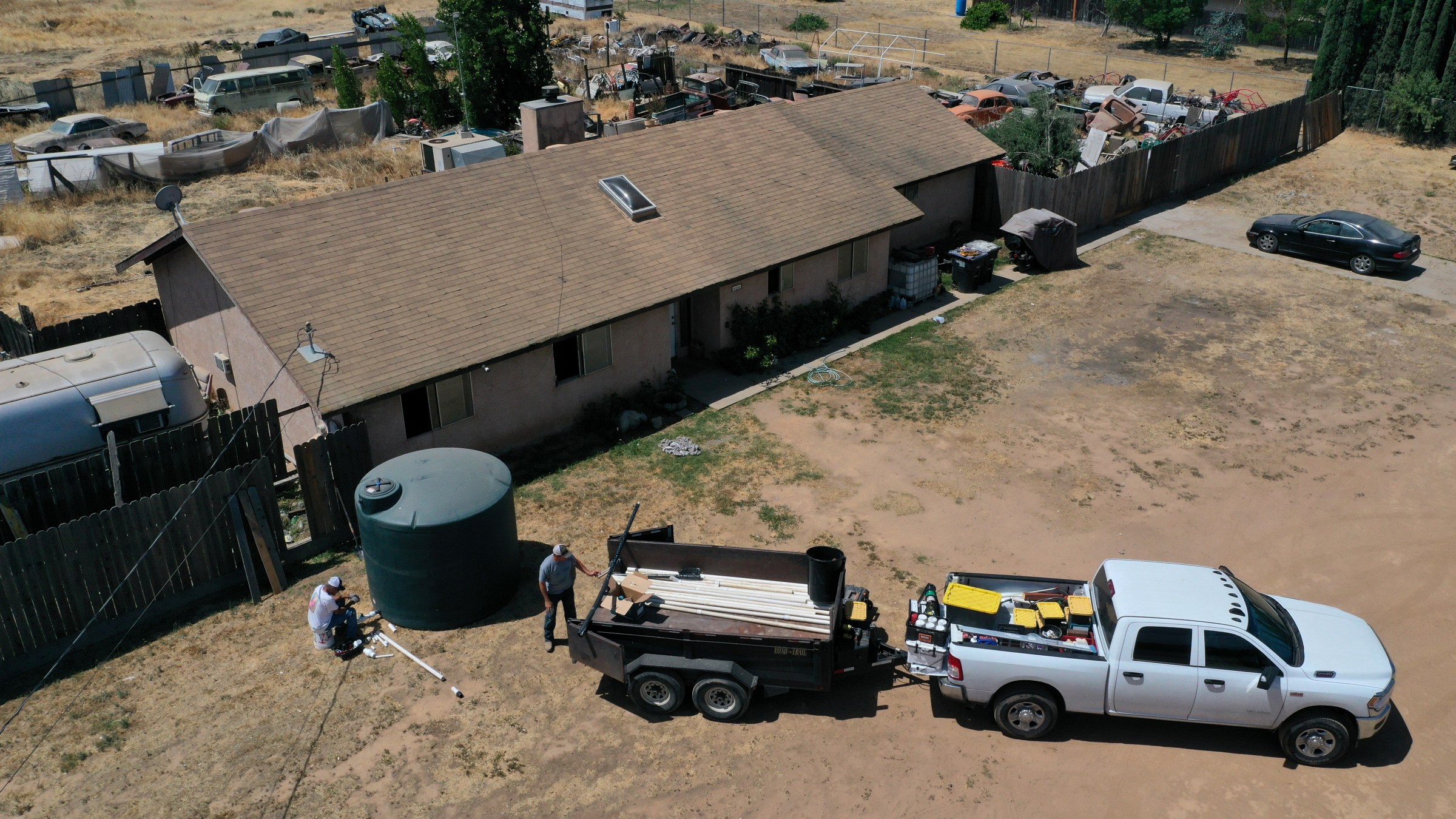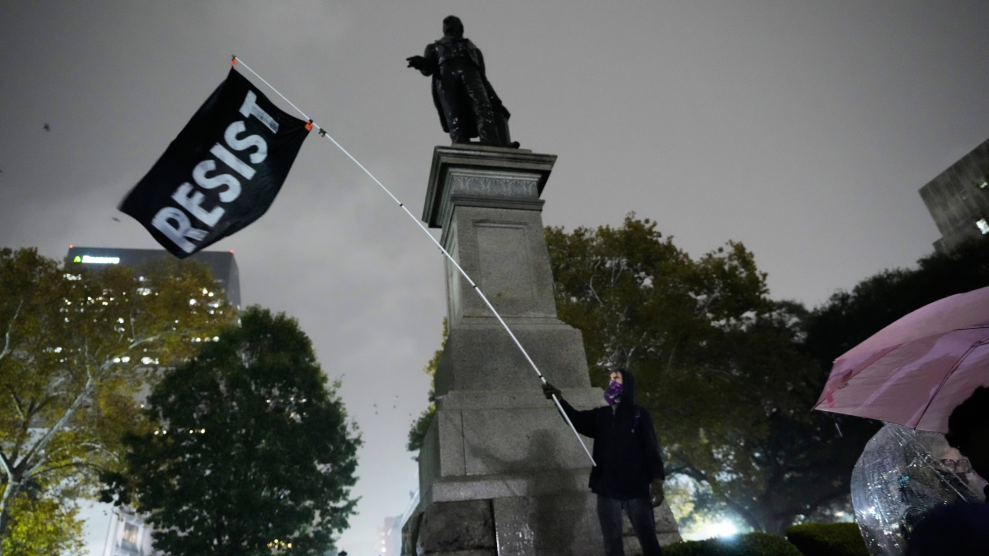The trouble began in 2017, when Rafael Bolaños’ sprinklers started to falter. He’d bought his three-bedroom, one-bath house on 2 acres in 2002, when supply from the property’s well was plentiful. But over the years, more pistachio groves sprouted in the grassy fields surrounding his town of Madera, California. After an epic four-year drought, the once-reliable well struggled to pull from the underground aquifer that the Bolaños family and their neighbors shared with the new trees. So Bolaños, a construction worker who lives with his wife, Lorena, and their 14-year-old daughter, shelled out more than $3,000 to deepen the well by 70 feet and replace its pump, worn from drawing ever-deeper water. He let his lawn and most of their prized fruit trees—orange, lime, and peach—die back, and took to hand-pumping to save the new equipment from wear and tear.
That kept just enough water running until May 2021, when California declared another drought emergency in the region, and the well started yielding just a few gallons a day. The family lived off bottled water until June, when a local nonprofit trucked in a 2,500-gallon tank and hooked it to the house’s pipes. They return with a refill every couple of weeks. Households—many of his neighbors are also now hooked to tanks—are given enough for each resident to use about 50 gallons a day; the national average falls between 80 and 100 gallons. Bolaños says a neighbor told him that a new, deeper well would cost at least $25,000. “We can’t sell our house if it doesn’t have water,” he says. “But if we pay for a new well, how can we be sure it won’t go dry in a few years, too?”
Madera lies in the heart of the San Joaquin Valley, whose nut groves, fruit and vegetable fields, and industrial-scale dairy operations contribute mightily to the US food supply. But the area faces intensifying climate chaos: record heat, wildfire smoke, and its second historic drought in a decade. These disasters have yet to make a big dent in the bounty that the region provides to the nation’s supermarkets, but residents can’t avoid the wrath. Many face the same riddle as the Bolaños: wondering where the water went and how to get it back.
The valley’s farms consume 89 percent; residents just 3 percent. Embedded in what’s largely a desert, San Joaquin’s vast agriculture industry relies on both snowmelt from the Sierra Nevada mountains and underground aquifers that took millennia to develop. As climate change reduces snowpack, farmers have scrambled to be first in line at the aquifers and to wring every penny out of the dwindling supply by planting lucrative crops with robust overseas markets. Almonds and pistachios have supplanted less profitable vegetables, fruit, and cotton. But while fields of row crops can be left fallow during droughts, nut trees must be continuously irrigated. Since 1990, nut acreage in the valley has quadrupled, while alfalfa, grapes, and vegetable crops have stagnated or declined and groundwater overdraft has risen.
According to figures from the California Department of Water Resources, 973 residential wells went dry in 2021; just 85 did the year before. More than 70 percent are in the San Joaquin Valley. As of November 9, Self-Help Enterprises, the nonprofit that supplies water to the Bolaños, was managing a record 734 tanks in the region—up from 340 in 2020. “We are swamped,” says Marliez Diaz, the group’s Visalia-based water sustainability manager.
Those tanks are a stopgap measure. Meanwhile, well diggers are experiencing a triple whammy of spiking demand, labor shortages, and the need to go deeper to find water. “Drillers are backed up eight to nine months,” Diaz says, with prices soaring accordingly. “It’s crazy. We used to be able to drill a [residential] well for $20,000. Now we can’t drill anything for less than $40,000.”
In an attempt to stop the race to the bottom of its aquifers, in 2014 California’s legislature broke a long tradition of refusing to regulate them by passing the Sustainable Groundwater Management Act (SGMA). Under the law, the San Joaquin aquifers qualified as “critically overdrafted;” the state carved the valley and other stressed regions into geologically based basins, each of which would form a local Groundwater Sustainability Agency and develop plans to keep aquifer levels steady by 2040.
The law tasked each GSA with setting a “minimum threshold” for how low the aquifers can go before restrictions on heavy users kick in, raising hopes of ending the routine overpumping that farms have gotten away with for decades. But while the legislature instructed the boards to balance the needs of all groundwater users, including “disadvantaged communities…served by private domestic wells or small community water systems,” they ended up dominated by large landowners and allied local politicians.
The plans have been submitted to the state Department of Water Resources, which has until the end of January to evaluate them. If approved as is, they’ll likely generate more misery. A June 2021 analysis by the Pacific Institute, a water think tank, found that 40 percent of the valley’s 1,200 public supply wells—which serve more than 1 million people but tend to be shallower than agricultural ones—will go partially or fully dry by 2040. The study, which examined 31 draft plans from the valley, also found that the most vulnerable water systems are twice as likely to be in communities with median annual household incomes below $50,000. Another report from the Water Foundation anticipates 4,000 to 12,000 private wells, like the Bolaños’, will dry up. Indeed, in the basin they call home, the proposed plan would destroy at least 106 of 129 wells, according to the California-based Leadership Counsel for Justice and Accountability.
Kristin Dobbin, a UCLA ecologist, interviewed 40 residents across the valley while studying community involvement in implementing the act. “They often reported that they were told—or got the sense—that SGMA didn’t have anything to do with drinking water, that such concerns were beyond the scope of the law,” she says. And poorer residents were largely excluded from the process, says Community Water Center attorney Justine Massey. Meetings were often during working hours; at them, Massey says she witnessed residents raise concerns about their water supply, only to be told, “Thank you for your comment,” without any consideration of a fix. A May 2021 report from the state’s Legislative Analyst’s Office confirms that “the communities that lost—or remain vulnerable to losing—access to safe drinking water contain high proportions of both lower-income and Latino residents.”
In June 2019, the center held a “water strike”—no one drank for an hour—at the state Capitol, with demonstrators listening to a fiery address by the legendary farmworker organizer Dolores Huerta. Weeks later, Gov. Gavin Newsom signed a budget authorizing $130 million per year to expand access to clean water. This past spring, he followed up with an executive order calling on state agencies to develop “principles and strategies to monitor, analyze, and minimize impacts to drinking water wells.” Massey hopes Newsom’s action will pressure the Department of Water Resources to enforce the state’s nearly decade-old right-to-water bill and reject many of the plans. “We’ll see,” she adds.
So far, the DWR is training a skeptical eye on the San Joaquin Valley’s groundwater plans. As of early January, the agency has notified 30 of the region’s Groundwater Sustainability Agencies that their GPSs lacked details about how they’d prevent widespread well failures and declining water quality.
With a failed well undermining their home’s value, the Bolaños family has no hope of selling. And housing in nearby places like Fresno—where Rafael works—remains prohibitively expensive. But without a steady water supply, staying put isn’t much of an option either. “We could save for a well instead of saving for our daughter’s college,” Lorena says. “But it would be a gamble. We could never afford a well as deep as those of the farmers.”
This article has been revised and updated after a print version was featured in our January/February 2022 issue.

















